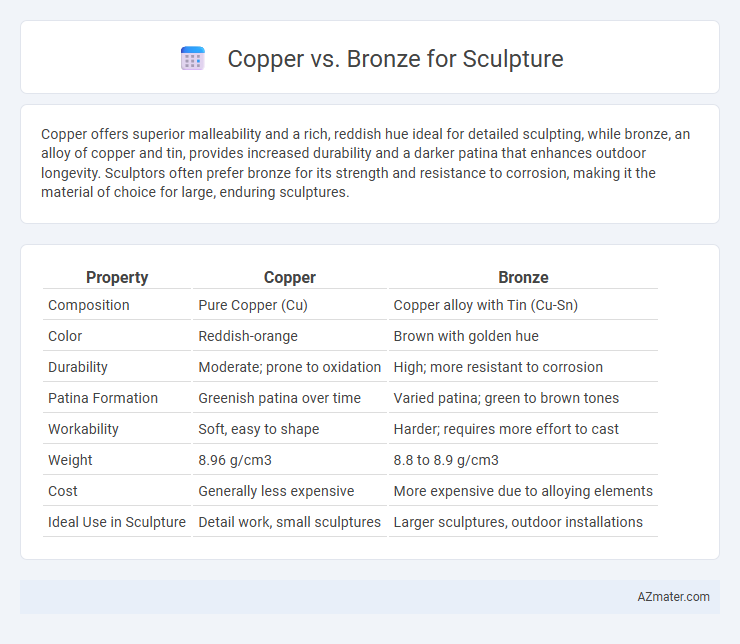Copper offers superior malleability and a rich, reddish hue ideal for detailed sculpting, while bronze, an alloy of copper and tin, provides increased durability and a darker patina that enhances outdoor longevity. Sculptors often prefer bronze for its strength and resistance to corrosion, making it the material of choice for large, enduring sculptures.
Table of Comparison
| Property | Copper | Bronze |
|---|---|---|
| Composition | Pure Copper (Cu) | Copper alloy with Tin (Cu-Sn) |
| Color | Reddish-orange | Brown with golden hue |
| Durability | Moderate; prone to oxidation | High; more resistant to corrosion |
| Patina Formation | Greenish patina over time | Varied patina; green to brown tones |
| Workability | Soft, easy to shape | Harder; requires more effort to cast |
| Weight | 8.96 g/cm3 | 8.8 to 8.9 g/cm3 |
| Cost | Generally less expensive | More expensive due to alloying elements |
| Ideal Use in Sculpture | Detail work, small sculptures | Larger sculptures, outdoor installations |
Introduction to Copper and Bronze in Sculpture
Copper and bronze have been foundational materials in sculpture for millennia, with copper offering a pure metallic luster and excellent malleability ideal for detailed work. Bronze, an alloy of copper and tin, provides enhanced strength, durability, and resistance to corrosion, making it a preferred choice for outdoor sculptures and large-scale monuments. The choice between copper and bronze significantly influences the sculpture's longevity, texture, and patina development over time.
Historical Use of Copper and Bronze in Art
Copper has been used in sculpture since ancient times, with artifacts dating back over 10,000 years, due to its natural malleability and warm patina. Bronze, an alloy of copper and tin, emerged around 3300 BCE during the Bronze Age, revolutionizing art with its superior strength, durability, and ability to capture fine details, as seen in iconic works like the Riace Warriors and the Greek Classical statues. Historical usage of bronze in sculptures reflects advancements in metallurgy that enabled larger, more intricate, and longer-lasting artworks compared to pure copper.
Composition and Material Properties
Copper, a pure element with excellent malleability and corrosion resistance, allows for detailed and durable sculptures but can oxidize to a green patina over time. Bronze, an alloy primarily of copper and tin, offers enhanced strength, hardness, and a lower melting point, making it ideal for casting complex, long-lasting sculptures. The addition of tin in bronze improves tensile strength and brittleness compared to copper, resulting in more robust and resilient artworks.
Workability and Sculpting Techniques
Copper offers excellent malleability and ductility, allowing artists to create intricate details through hammering, chasing, and repousse techniques. Bronze, an alloy of copper and tin, provides greater hardness and durability, enabling more refined casting methods like lost-wax casting while maintaining sufficient workability for chasing and chasing. Sculpture workability in bronze benefits from its lower melting point and reduced shrinkage, resulting in precise final forms with enhanced surface detail.
Durability and Longevity
Copper sculptures exhibit superior corrosion resistance due to the natural patina that forms, protecting the metal from environmental damage and enhancing durability over time. Bronze, an alloy of copper and tin, offers increased hardness and strength, resulting in better structural integrity and resistance to wear. Both materials provide exceptional longevity, but bronze's added alloy components contribute to enhanced durability in intricate sculptures exposed to harsh outdoor conditions.
Color, Patina, and Aesthetic Qualities
Copper sculptures exhibit a warm, reddish-orange color that intensifies with age, developing a natural greenish or bluish patina known as verdigris, which adds unique character and corrosion resistance. Bronze, an alloy primarily of copper and tin, presents a darker, brownish-golden tone that darkens over time and forms a stable, often greenish or black patina used to enhance texture and detail. Artists often prefer bronze for its durability, fine detail retention, and controlled aging, while copper is chosen for its vibrant initial color and more dynamic patina transformations, influencing the overall aesthetic impact of sculptures.
Cost and Availability
Copper offers a lower initial cost than bronze, making it more accessible for budget-conscious sculptors. Bronze, an alloy primarily of copper and tin, typically incurs higher expenses due to the added materials and complex production process. While copper is more readily available in pure form worldwide, bronze's availability depends on alloy composition and supplier sourcing, potentially increasing lead times for artists.
Applications in Contemporary Sculpture
Copper is prized in contemporary sculpture for its malleability and vibrant natural patinas that develop over time, enhancing aesthetic appeal and durability in outdoor installations. Bronze, an alloy of copper and tin, is favored for its superior strength and resistance to corrosion, making it ideal for large-scale, intricate sculptures requiring longevity and structural integrity. Artists often select bronze for fine detail work and public art due to its ability to capture sharp textures and maintain stability in varying environmental conditions.
Maintenance and Restoration
Copper sculptures require regular cleaning and protective waxing to prevent oxidation and green patina buildup, ensuring long-term durability with minimal corrosion. Bronze, an alloy of copper and tin, develops a more stable patina that acts as a protective layer, reducing maintenance frequency and making restoration processes less intensive. Restoration of bronze sculptures often involves patina preservation techniques and gentle cleaning, while copper pieces demand more careful monitoring to avoid surface degradation and corrosion.
Choosing the Right Material for Your Sculpture
Copper offers excellent malleability and a distinct reddish hue ideal for detailed sculptures requiring fine textures and vibrant patinas. Bronze, an alloy of copper and tin, provides enhanced durability and resistance to corrosion, making it suitable for outdoor sculptures exposed to environmental elements. Selecting between copper and bronze depends on the desired finish, structural strength, and exposure conditions of the artwork.

Infographic: Copper vs Bronze for Sculpture
 azmater.com
azmater.com